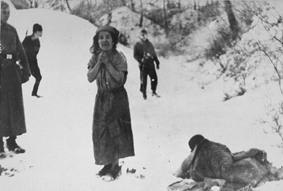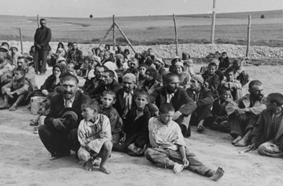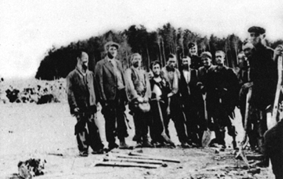
A woman about to be executed in Belzec extermination camp.
The soldier on the left is a SS guard, the soldiers in the background are Ukrainian guards. Picture found on a SS prisoner.
Established November 1st, 1941, Belzec extermination center consisted of two camps divided into three parts: administration section, barracks and storage for plundered goods, and extermination section. Initially, there were three gas chambers using carbon monoxide housed in a wooden building. They were later replaced by six gas chambers in a brick and concrete building. Belzec extermination center began operations March 17th, 1942 and ended operations December 1942. The estimated number of deaths is 500-600,000, mainly Jews.

A woman about to be executed in Belzec extermination camp.
The soldier on the left is a SS guard, the soldiers in the background are Ukrainian guards. Picture found on a SS prisoner.
Belzec extermination camp, the model for two others in the 'Aktion Reinhard' murder program, started as a labor camp in April 1940. Situated in the Lublin district, it was conveniently between the large Jewish populations of south east Poland and eastern Galicia. Construction began on November 1st 1941, using labor from the preexisting labor camp and local Jewish communities. SS Colonel General Christian Wirth, a former police officer who had played a leading role in implementing the T4 euthanasia program', was appointed the first camp commander. He commanded 20-30 SS men, plus a guard company of 90-120 Ukrainians who were trained at the Trawniki camp.
Belzec extermination camp was quite small, with a circumference of +- 1,220 yards. It was divided into two sections, each one surrounded by a barbed wire fence. There were watch towers all around the main perimeter. The first camp was split into two parts. The smaller area contained the administration buildings and the Ukrainians barracks. The larger part included the spur line which carried rail trucks into the camp, an expanse where the Jewish deportees were sorted into groups of men or women and children, the barracks where they were forced to undress and were shaven, storerooms for their clothes, personal objects, etc..., and huts for the Jewish workers who were employed by the SS to carry out the duties associated with the murder process.
The second camp housed the gas chambers and burial pits. It was reached by a long, narrow passageway with barbed wire fencing on either side, known as 'the tube'. The extermination site was screened off from the rest of the camp by leafy branches intertwined with the barbed wire.
Camouflage was essential to the murder process. A transport numbering 40-60 rail trucks, holding about 2-2,500 Jews, would arrive at Belzec station. It would be divided into two or three smaller convoys which would be pushed into the camp. The Jews would then be rapidly disembarked onto the platform where they were assured that they had arrived at a transit camp. They were told that before being assigned to labor duties elsewhere they would be disinfected and showered. Men were separated from women and children and marched off to large huts where they undressed. Women had their hair shaven off. They were then brutally pushed to 'the tube' and into the gas chambers which were disguised as 'showers'. The brutalized and disoriented Jews, often weak from hours or days spent in cattle trucks, had barely any time to evaluate their fate or react defensively.

Gipsies in Belzec before being sent to the gas chamber
In the first phase of its operations, from mid-March 1942 to mid-May 1942, Belzec had three gas chambers in a wooden barrack with a double wall filled with sand. The gas chambers were half-lined with tin and equipped with two airtight doors, one for entry and one through which corpses were removed. The carbon monoxide gas was piped in from a diesel engine mounted outside. Once the gas chambers were filled and the doors shut, the killing process took up to 30 minutes. Teams of Jewish laborers who had been selected from earlier transports then removed the corpses and dragged them to burial pits. Other Jewish workers removed gold teeth from the bodies. Back at the platform, teams of Jews cleaned up the trucks and tidied the platform. In the undressing rooms more Jewish work units were busy sorting clothing, luggage's and personal objects. It took up to three hours to 'process' one section of a transport.
In mid-May the transports stopped while the system was refined. In mid-June, construction began on a brick and concrete building housing six gas chambers, each one 13 by 16 feet. This enabled the SS to kill up to 1,200 Jews at a time, which meant that trains needed to be broken down into only two parts. Jews could also be moved through all the stages of undressing and shaving more quickly. During this period, about 1,000 Jews were kept alive for short periods of time to man the various work teams. A substantial number were employed by the SS as craftsmen. All were liquidated after a while. Those remaining when the camp ceased to function were transported to Sobibor death camp and murdered. There were only a handful of survivors of Belzec.
It is estimated that about 600,000 Jews were murdered at Belzec and probably dozen thousands of Gypsies. In the first phase of its operations, 80,000 Jews were killed, having been brought from the ghettos of Lublin, Lvov and elsewhere in the Lublin area and Eastern Galicia. The second phase, from mid-July 1942 to the end of December 1942, saw the arrival and gassing of 130,000 Jews from the Cracow area, 215,000 from the Lvov region and smaller numbers from Lublin and Radom.
During the early months of 1943, the corpses of the murdered Jews were disinterred and burned in open air pits. The camp was then closed. However, local people excavated the ground for valuables and had to be driven off by guards. To deter other scavengers, the area of the camp was ploughed over and turned into a farm. One of the Ukrainian guards was made the farmer.

The Sonderkommando of Belzec. Please note that the guard in the background is smiling...